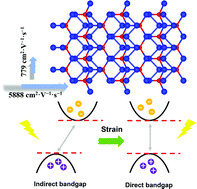Mechanical, electronic and optical properties of a novel B2P6 monolayer: ultrahigh carrier mobility and strong optical absorption†
Abstract
Two-dimensional (2D) materials with a moderate bandgap and high carrier mobility are useful for applications in optoelectronics. In this work, we present a systematic investigation of the mechanical, electronic and optical properties of a B2P6 monolayer using first-principles calculations. Monolayer B2P6 was estimated to be an anisotropic material from direction-dependent in-plane Young's moduli and Poisson's ratios. Also, B2P6 exhibits an ultrahigh electron mobility of ∼5888 cm2 V−1 s−1, showing advantages for application in high-speed optoelectronic devices. More importantly, for the B2P6 monolayer, a desirable transformation from an indirect to direct band gap was observed at a biaxial tensile strain of ∼4%. Increasing the biaxial strain reduces the gap and preserves the suitable band edge positions for photocatalytic water splitting in the observed strain range of 1–8%. The decreased gap also enhances the visible light absorption of the B2P6 monolayer. These findings indicate that the B2P6 monolayer has promising applications in photocatalytic and photovoltaic devices.



 Please wait while we load your content...
Please wait while we load your content...